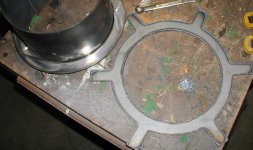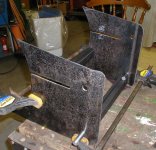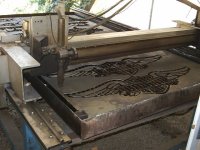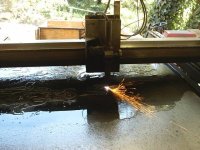Accuracy: Well, the plasma process itself is subject to a bevel that happens depending on the cut travel direction. The bevel is between 3 and 8 degrees. On thinner materials, it all but disappears. When you get to about 1/8 inch, it becomes noticable. Another factor is the cut kerf. The kerf width depends on the height above the material you hold the torch, and the condition of the tip and other consumables. If you virtually drag the tip on the workpc, and your tip is new, it makes only about 0.025" (twenty-five thousandths of an inch) wide kerf. So inside corners are automatically filleted at .025" diameter, if they are drawn as square corners. If the software you use incorporates cutter compenstation, this kerf does not change the part. On my software (Master 5), it is not included so I am adding it with a different pre-processing program. This way, the cut line is fed to the controller card at 0.025" (or whatever you define) offset to the outside, so your finished part meets the original dimensions. On holes, the offset is to the inside of the line, to leave the hole the proper dimensions. There is of course some play in the motor/gear system, but that is much less than half the kerf width. Also, sometimes resonances can be set up by the rate and direction the motors are running, which can cause a slightly "knotchy" edge.
With all the above taken into account, except ignoring the bevel which is an unpredictable annoyance, I figure the accuracy overall to be within 0.020" of the desired final size, end to end of the part dimensions. This is of course way close enough for any welded assembly. Some of the parts this thing cuts out still amaze me and I have used it for over two years and maybe a hundred different parts now. Anything I draw now can have really nice stress-relieving and safety-providing curved edges, and the plasma cutter happily cuts them all perfectly, without question. /forums/images/graemlins/grin.gif
The motors I chose are plenty big enough for the mass they move, and the plasma does not resist motion like a router or mill would. Always remember that the power you need depends on the mass and the speed you want to move it. Tests have shown my system maintains accuracy a speed that is about 5 times as fast as the proper speed for the thinnest material I cut (sorry I cannot remember the exact units right now). So I have a fast speed for testing the layout of the part on the particular pc of metal I have chosen to throw on the table, and also the fast speed to move between cutting operations, but then it slows to a speed appropriate for the material I am cutting. The only time I have any issues with accuracy is if I happen to forget to connect the extra ground clamp to the workpiece. If the workpiece is not grounded seperately of the plasma ground clamp, it "radiates" interference which will sometimes get into the control loop and carry the torch off in a random direction. Thats always fun. /forums/images/graemlins/mad.gif



